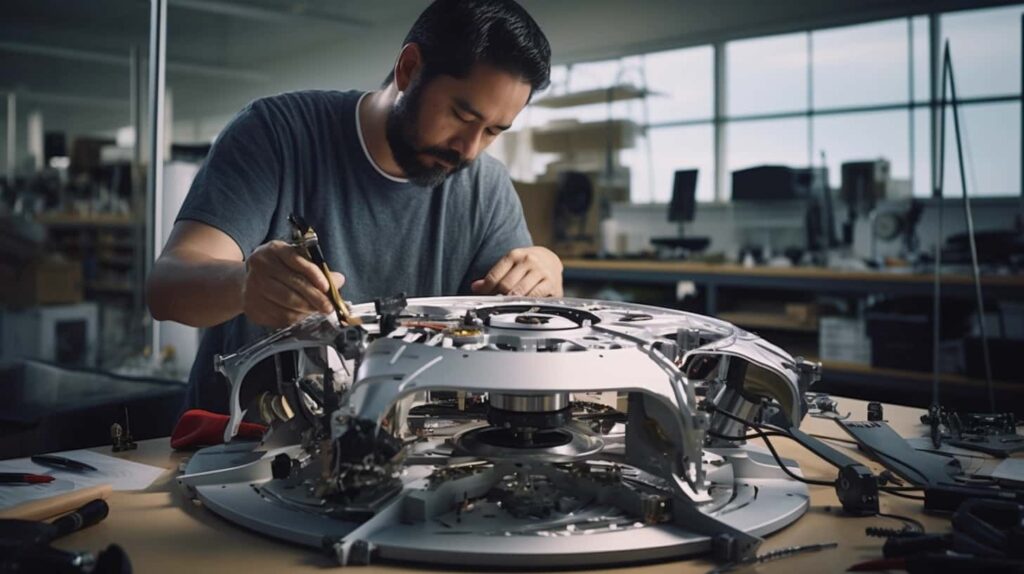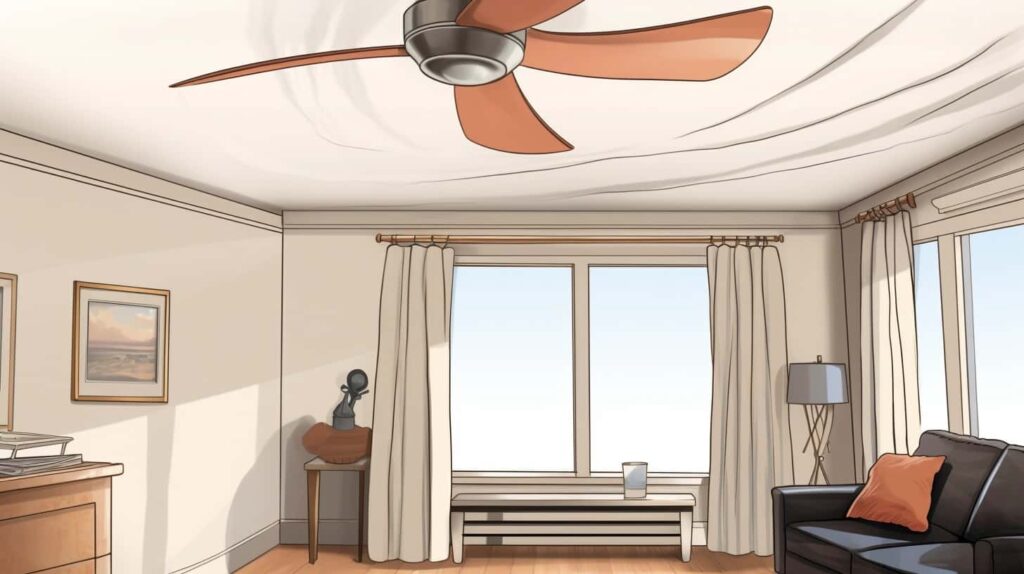Appliances
How Do Smart Ceiling Fans Work

Were you aware that intelligent ceiling fans go beyond the capabilities of traditional fans? These fans come with cutting-edge technology, enabling easy and effective control.
In this article, we will explore how smart ceiling fans work and the various features that make them stand out. From integration with smart home systems to voice control and remote access via mobile apps, these fans offer a whole new level of convenience and comfort.
With smart sensors and automated functionalities, they can adapt to your preferences and create personalized experiences. Not only do they provide a refreshing breeze, but they also help save energy and enhance the overall efficiency of your home.

Let’s delve into the fascinating world of smart ceiling fans and discover the many benefits they bring.
Key Takeaways
- Smart ceiling fans have wireless connectivity through integrated Wi-Fi or Bluetooth modules.
- They incorporate sensors for enhanced automation, such as temperature, humidity, and occupancy sensors.
- Smart ceiling fans can be controlled remotely using dedicated mobile apps or voice commands.
- Integration with smart home systems allows for synchronization with other devices and control through the smart home system’s app or automation rules.
Components of Smart Ceiling Fans
Smart ceiling fans consist of several essential components that work together to provide advanced functionality and convenience. One of the key components of smart ceiling fan design is its wireless connectivity feature. This allows the fan to connect to other smart devices in a home or office, such as smartphones, tablets, or voice-controlled assistants like Amazon Alexa or Google Assistant.
To achieve wireless connectivity, smart ceiling fans are equipped with integrated Wi-Fi or Bluetooth modules. These modules enable the fan to establish a connection with the local network or directly with compatible devices. By connecting to the network, users can control the fan remotely using dedicated mobile apps or voice commands.
In addition to wireless connectivity, smart ceiling fans also incorporate sensors for enhanced automation. These sensors can detect temperature, humidity, and occupancy, allowing the fan to automatically adjust its speed and direction based on the environmental conditions. For example, if the room becomes too warm or humid, the fan can increase its speed to provide better ventilation.
Moreover, smart ceiling fans often come with built-in LED lights that can be controlled independently. This allows users to adjust the brightness and color temperature of the lights to create different ambiances in the room.
Integration With Smart Home Systems
Many smart ceiling fans can seamlessly integrate with various smart home systems, allowing users to control their fans alongside other connected devices. This compatibility is achieved through the use of wireless protocols and communication standards.
Here are four key aspects to consider when it comes to integrating smart ceiling fans with smart home systems:

- Smart Ceiling Fan Compatibility: Not all smart ceiling fans are compatible with every smart home system. It’s important to ensure that the fan you choose supports the same communication protocol as your existing smart home system. Common protocols include Wi-Fi, Bluetooth, Zigbee, and Z-Wave.
- Integration Challenges: Integrating smart ceiling fans with smart home systems can sometimes be challenging due to compatibility issues. Different manufacturers may use different protocols or have their own proprietary systems. This can make it difficult to connect and control the fan using your smart home system.
- Installation and Setup: Proper installation and setup are crucial for successful integration. This may involve connecting the fan to your home’s Wi-Fi network, configuring settings through a mobile app, or using a hub or bridge device to facilitate communication between the fan and your smart home system.
- Control and Automation: Once integrated, you can control your smart ceiling fan through your smart home system’s app, voice commands, or even through automation rules. This allows you to adjust fan speed, set timers, and create schedules based on your preferences or other connected devices in your home.
Voice Control and Virtual Assistants
We can control smart ceiling fans through voice commands and virtual assistants. Voice recognition technology allows us to interact with our ceiling fans using simple verbal instructions. By integrating with virtual assistants like Amazon Alexa or Google Assistant, smart ceiling fans become part of our connected home ecosystem. This integration allows us to control the fan’s speed, change the direction of the blades, and adjust the lighting, all through voice commands.
Voice recognition technology has come a long way in recent years, thanks to advancements in artificial intelligence (AI). These AI-powered virtual assistants can understand and interpret our voice commands, enabling a seamless and intuitive control experience. They can also learn our preferences over time and adapt to our unique needs, making the control of smart ceiling fans even more personalized and effortless.
With voice control and virtual assistants, we can enjoy the convenience of controlling our smart ceiling fans without having to reach for a remote or a smartphone. Simply speaking a command to our virtual assistant, such as ‘Hey Google, turn on the fan,’ or ‘Alexa, set the fan speed to medium,’ is all it takes to adjust the fan settings and create the ideal indoor environment.

Remote Access and Control via Mobile Apps
Remote access and control of smart ceiling fans can be achieved through mobile apps, allowing users to adjust settings and preferences from their smartphones. This feature enhances the convenience and flexibility of using smart ceiling fans, as users can control their fans from anywhere within the range of their Wi-Fi network.
Here are four notable mobile app features and remote control capabilities that make smart ceiling fans even more versatile and user-friendly:
- Speed and direction control: With the mobile app, users can easily adjust the fan speed and change the direction of airflow to suit their preferences. This allows for optimal comfort and energy efficiency.
- Scheduling and timers: The mobile app enables users to set schedules and timers for their smart ceiling fans. This feature allows users to automate the fan’s operation based on their daily routine, helping to save energy and create a comfortable living environment.
- Smart home integration: Many smart ceiling fan mobile apps offer integration with popular smart home platforms such as Google Assistant or Amazon Alexa. This allows users to control their fans using voice commands and create customized scenes with other smart devices in their home.
- Energy monitoring and usage statistics: Mobile apps often provide real-time energy monitoring and usage statistics, allowing users to track the energy consumption of their smart ceiling fans. This information helps users make informed decisions to further optimize energy usage and save costs.
Energy-Saving Features and Efficiency
Smart ceiling fans offer a range of energy-saving features and are designed to maximize efficiency. These fans come with energy-efficient settings that allow users to adjust the speed and airflow to minimize energy consumption.
Additionally, smart sensors are integrated into the fans to optimize their performance based on factors such as room occupancy and temperature.

Energy-Efficient Fan Settings
To enhance energy efficiency, smart ceiling fans are equipped with various energy-saving features and settings. These settings allow users to optimize the fan’s operation according to their preferences and energy conservation goals. Here are four energy-efficient fan settings commonly found in smart ceiling fans:
- Speed Control: Smart ceiling fans offer multiple speed options to ensure optimal airflow while minimizing energy consumption. Users can adjust the fan speed based on their cooling needs, allowing them to save energy when cooling requirements are lower.
- Timer Function: The timer function in smart ceiling fans enables users to set a specific operating duration. This feature ensures that the fan operates only when needed, reducing unnecessary energy consumption.
- Occupancy Sensors: Some smart ceiling fans are equipped with occupancy sensors that detect motion in a room. These sensors automatically turn on or adjust the fan speed when someone enters the room and turn it off when the room is unoccupied, saving energy.
- Integration with Smart Home Automation Systems: Smart ceiling fans can be integrated with smart home automation systems, allowing users to control the fan’s settings remotely using their smartphone or voice commands. This feature enables users to optimize energy consumption by adjusting the fan settings based on occupancy, time of day, or weather conditions.
Smart Sensors for Optimization
With a focus on energy-saving features and efficiency, smart ceiling fans utilize smart sensors to optimize their operation and enhance energy conservation. These sensors play a crucial role in monitoring and adjusting the fan’s performance based on the surrounding conditions. Two key sensors commonly found in smart ceiling fans are temperature sensors and humidity sensors.
Temperature sensors detect the ambient temperature in the room and provide valuable data for the fan to automatically adjust its speed and airflow. By analyzing the temperature readings, the fan can determine if it needs to increase or decrease its speed to maintain a comfortable environment.
Humidity sensors, on the other hand, measure the moisture content in the air. This information allows the fan to adapt its operation to control humidity levels. By automatically adjusting the fan speed, it can help prevent the growth of mold and mildew, ensuring a healthier living space.
By incorporating these smart sensors for temperature and humidity control, smart ceiling fans can optimize their performance, reduce energy consumption, and provide a more comfortable and efficient cooling experience.
| Sensor Type | Function |
|---|---|
| Temperature | Monitors ambient temperature and adjusts fan speed accordingly |
| Humidity | Measures moisture content in the air for humidity control |
Smart Sensors and Automated Functionalities
Smart ceiling fans are equipped with sensor technology that allows them to detect changes in temperature, humidity, and occupancy. These sensors enable the fans to automatically adjust their speed and direction based on the surrounding conditions, optimizing comfort and energy efficiency.
With automated fan controls, users can set predefined schedules or use smart home integration to control the fans remotely, further enhancing their convenience and functionality.

Sensor Technology
Sensor technology plays a crucial role in the functionality of smart ceiling fans, enabling automation and enhanced efficiency. Advancements in sensor technology have paved the way for innovative smart sensor applications in ceiling fans.
Here are four key ways that sensor technology enhances the performance of smart ceiling fans:
- Occupancy Sensors: Smart ceiling fans equipped with occupancy sensors can detect human presence in a room. This allows the fan to automatically turn on or adjust its speed based on the occupancy, saving energy when the room is unoccupied.
- Temperature Sensors: By monitoring the temperature in a room, smart ceiling fans can automatically adjust their speed or activate other cooling or heating devices to maintain a comfortable environment.
- Humidity Sensors: Humidity sensors in smart ceiling fans can detect the moisture levels in a room. This enables the fan to automatically adjust its speed or activate a dehumidifier to prevent mold and maintain optimal air quality.
- Light Sensors: Light sensors integrated into smart ceiling fans can detect the ambient light levels in a room. This enables the fan to adjust its speed or turn on/off the light accordingly, providing convenience and energy savings.
Automated Fan Controls
Automated fan controls revolutionize the functionality of smart ceiling fans by seamlessly integrating smart sensors and automated functionalities. These controls offer advanced features such as automated scheduling and temperature regulation, allowing users to optimize comfort and energy efficiency.
The table below provides an overview of the key features and benefits of automated fan controls:
Features Benefits Automated scheduling Set fan operation based on time and user preferences. Temperature regulation Adjust fan speed based on room temperature. Smart sensor integration Utilize data from sensors to optimize fan performance. Energy efficiency Reduce energy consumption and lower utility bills.
With automated scheduling, users can program their smart ceiling fans to turn on or off at specific times, ensuring a comfortable environment without the need for manual operation. Temperature regulation feature adjusts the fan speed based on the room’s temperature, providing optimal airflow and cooling. Smart sensor integration enables the fan to respond to changes in temperature or occupancy, further enhancing energy efficiency and comfort.
Customizable Settings and Personalized Experiences
Users can customize the settings of smart ceiling fans to create personalized experiences based on their preferences. Smart ceiling fans offer a range of customizable features that allow users to tailor their fan’s operation to suit their specific needs and preferences for personalized comfort.

Here are four key ways users can customize their smart ceiling fan settings:
- Fan speed control: Users can select from multiple fan speed options to find the perfect balance between air circulation and noise level. This allows for personalized comfort based on individual preferences and room conditions.
- Direction control: Smart ceiling fans allow users to change the direction of the fan blades to either clockwise or counterclockwise rotation. This feature is particularly useful during different seasons, as it can help distribute warm or cool air effectively throughout the room.
- Timer settings: Users can schedule their smart ceiling fans to turn on or off at specific times. This feature enables users to have their fans automatically start before they enter a room or turn off after they leave, ensuring a comfortable environment without wasting energy.
- Smart assistant integration: Smart ceiling fans can be integrated with popular smart assistants like Amazon Alexa or Google Assistant. This allows users to control their fan using voice commands, creating a hands-free and personalized experience.
Benefits and Advantages of Smart Ceiling Fans
Smart ceiling fans offer a multitude of benefits and advantages that enhance the overall functionality and convenience of traditional ceiling fans. With the integration of smart ceiling fan technology, users can experience a new level of convenience and comfort in their homes.
One of the key advantages of smart ceiling fans is their ability to be controlled remotely. Through the use of a smartphone app or voice commands, users can easily adjust the fan speed, turn the fan on or off, and even set up schedules or routines. This eliminates the need to physically reach for a switch or pull chain, providing a seamless and effortless experience.
Another benefit is the ability to integrate smart ceiling fans into existing smart home systems. By connecting the fan to platforms such as Amazon Alexa or Google Assistant, users can control not only their fan but also other smart devices in their home. This integration allows for a cohesive and synchronized smart home experience, where users can control their lights, thermostat, and fan settings all in one place.
The following table illustrates the benefits and advantages of smart ceiling fans:
Benefits Advantages Remote control Adjust fan settings conveniently from anywhere Smart home integration Seamlessly integrate with other smart devices Energy efficiency Optimize energy consumption for cost savings
Do Smart Ceiling Fans Have the Same Functions as Regular Ceiling Fans?
Yes, smart ceiling fans offer all the basic uses of ceiling fans, such as providing airflow and cooling down a room. However, they also come with added features like remote control, compatibility with smart home systems, and energy-saving settings.
Frequently Asked Questions
Does a Smart Ceiling Fan Require a Separate Hub or Bridge to Connect to My Smart Home System?
A smart ceiling fan can indeed require a separate hub or bridge to connect to your smart home system. This compatibility feature allows for seamless integration and control of your fan through your smart devices.
The advantages of smart ceiling fans include the ability to remotely adjust settings, set schedules, and even monitor energy usage. By connecting to your smart home system, you can effortlessly optimize your comfort and energy efficiency.

Can I Control the Speed and Direction of a Smart Ceiling Fan Using Voice Commands?
Yes, we can control the speed and direction of a smart ceiling fan using voice commands.
With voice control capabilities and built-in wifi connectivity, smart ceiling fans allow us to effortlessly adjust the fan speed and change the direction of the blades using simple voice commands.
This advanced feature enhances the convenience and ease of use, providing a seamless and hands-free experience in controlling our smart ceiling fan.
Are There Any Limitations to the Range of Remote Access and Control via Mobile Apps for Smart Ceiling Fans?
When it comes to the range of remote access and control via mobile apps for smart ceiling fans, there are indeed limitations.
The connectivity range can vary depending on factors such as the strength of the Wi-Fi signal and the distance between the fan and the mobile device.
It’s important to keep in mind that the range may be limited within certain areas of your home.
Therefore, it’s crucial to ensure a stable and strong Wi-Fi connection for optimal control and functionality.
How Do Smart Sensors in a Ceiling Fan Contribute to Energy Efficiency?
Smart sensors in a ceiling fan play a crucial role in enhancing energy efficiency. By utilizing smart sensor technology, these fans can detect occupancy and adjust their speed accordingly. This not only ensures optimal comfort but also saves energy by reducing unnecessary usage.
Additionally, smart ceiling fans often come equipped with energy-saving features such as programmable timers and smart home integration, allowing users to optimize their energy consumption.
Can I Schedule Different Fan Settings for Different Times of the Day Using a Smart Ceiling Fan?
Yes, we can schedule different fan settings for different times of the day using a smart ceiling fan.
By utilizing the advanced features of a smart ceiling fan, we can program it to automatically adjust its speed and mode based on our preferences and the time of day.
This allows us to have a comfortable and efficient airflow throughout the day without manual intervention.
If there are any issues with the scheduling or settings, we can troubleshoot the smart ceiling fan by checking the connectivity, power source, and app settings.

Conclusion
In conclusion, smart ceiling fans offer a plethora of advantages and benefits that make them a worthwhile addition to any home.
From integrating with smart home systems to providing remote access and control via mobile apps, these technologically advanced fans offer convenience and efficiency.
However, it’s ironic that while they claim to save energy, their automated functionalities and customizable settings may tempt users to keep them running longer than necessary.
Nevertheless, for those seeking a personalized and high-tech cooling experience, smart ceiling fans are an intriguing choice.
- About the Author
- Latest Posts
Introducing Ron, the home decor aficionado at ByRetreat, whose passion for creating beautiful and inviting spaces is at the heart of his work. With his deep knowledge of home decor and his innate sense of style, Ron brings a wealth of expertise and a keen eye for detail to the ByRetreat team.
Ron’s love for home decor goes beyond aesthetics; he understands that our surroundings play a significant role in our overall well-being and productivity. With this in mind, Ron is dedicated to transforming remote workspaces into havens of comfort, functionality, and beauty.
Appliances
3 Essential Tips for RV-Friendly Portable Washers

- Pros and cons of using eco friendly laundry detergent in a portable washer.
- Tips for preventing detergent residue buildup in a portable washer
Are you exhausted from constantly looking for laundromats during your RV trips? We get it. That’s why we’re here to provide three key tips for RV-friendly portable washing machines.
While you might be thinking, ‘Do I really need a portable washer?’ trust us, having one on your RV can be a game-changer. In this guide, we’ll show you how to choose the right size washer that fits your RV’s limited space, understand the power and water requirements to ensure smooth operation, and provide you with maintenance and cleaning tips to keep your washer running efficiently.
So, let’s dive in and master the art of laundry on the road!
Key Takeaways
- Consider the laundry capacity needed for your RV.
- Look for compact and lightweight options with space-saving features.
- Choose a portable washer with high energy efficiency and water conservation features.
- Regularly maintain and clean your portable washer using recommended cleaning products.
Choosing the Right Size
One of the first considerations when selecting a portable washer for our RV is determining the appropriate size. Portable washer features and space-saving options play a crucial role in making this decision. When it comes to size, it’s important to find a washer that fits well within the limited space of an RV, while still providing enough capacity to meet our laundry needs.
To begin with, portable washers come in a range of sizes, typically measured in pounds of laundry capacity. It’s essential to consider the amount of laundry we anticipate doing on a regular basis. While a smaller capacity may be suitable for individuals or couples, larger families might require a washer with a higher capacity to accommodate their laundry demands.
Additionally, it’s important to consider the physical dimensions of the washer. RVs have limited space, so opting for a compact and lightweight washer can help maximize the available room. Some portable washers are designed with space-saving features such as folding handles, detachable components, or even stackable options that can fit neatly into tight spaces.
Understanding Power and Water Requirements
When considering the power and water requirements for our RV-friendly portable washer, we need to understand the necessary resources for optimal performance.
Energy efficiency is an important factor to consider when choosing a portable washer for your RV. Look for models that have a high Energy Star rating, as this indicates that they consume less energy and can help you save on your electricity bills.

Additionally, portable washer features such as load sensing technology and adjustable water levels can help you conserve water. These features ensure that the washer only uses the amount of water necessary to clean your laundry, which is particularly crucial when you have limited water supply in your RV.
It’s also important to check the power requirements of the portable washer. Make sure that the washer is compatible with the power source available in your RV, whether it’s a standard 120-volt outlet or a 12-volt DC power source.
Understanding the power and water requirements of your RV-friendly portable washer won’t only help you achieve optimal performance but also contribute to energy and water conservation.
Maintenance and Cleaning Tips
Let’s talk about how to properly maintain and clean your RV-friendly portable washer. Taking care of your portable washer is essential to ensure its longevity and optimal performance. Regular maintenance and cleaning will help prevent any potential issues and keep your machine running smoothly. Here are some common troubleshooting tips and recommended cleaning products to keep in mind:
| Common Troubleshooting | Recommended Cleaning Products |
|---|---|
| Leaking water | Vinegar and water mixture |
| Excessive noise | Mild detergent |
| Drum not spinning | Baking soda |
| Error codes | Citric acid |
If you encounter a problem such as leaking water, try using a mixture of vinegar and water to clean the machine’s seals and hoses. For excessive noise, use a mild detergent to clean the drum and remove any debris that may be causing the noise. If the drum is not spinning, try using baking soda to remove any buildup that may be hindering its movement. Lastly, if you receive error codes, using citric acid in the detergent compartment can help clean the sensors and resolve the issue.
Remember to always refer to your portable washer’s manual for specific maintenance instructions and troubleshooting tips. By following these guidelines and using the recommended cleaning products, you can keep your RV-friendly portable washer in great condition and enjoy clean laundry on your travels.
Frequently Asked Questions
How Long Does It Typically Take to Wash a Full Load of Laundry Using a Portable Washer?
Typically, it takes around 30 to 45 minutes to wash a full load of laundry using a portable washer.
However, it’s important to consider the capacity limitations of these machines. Most portable washers have a smaller capacity compared to traditional washers, so it may take longer if you have a larger load.
It’s always a good idea to follow the manufacturer’s instructions and not overload the machine to ensure efficient and effective washing.
Can I Use Regular Laundry Detergent in a Portable Washer, or Do I Need to Use a Specific Type?
Yes, you can use regular laundry detergent in a portable washer. However, there are some pros and cons to consider.
Using eco-friendly laundry detergent in a portable washer is a great option for those who want to reduce their environmental footprint. It can be gentler on your clothes and safer for the environment.
However, some eco-friendly detergents may not be as effective at removing tough stains. To prevent detergent residue buildup, make sure to use the recommended amount of detergent and run an extra rinse cycle if needed.
Is It Safe to Leave a Portable Washer Unattended While It’s Running?
Safety precautions should be taken when using a portable washer unattended. There are potential risks involved, such as water leakage or electrical malfunctions. It’s important to follow the manufacturer’s instructions and guidelines for safe operation.
Some tips to minimize risks include ensuring a stable surface, avoiding overloading the machine, and regularly checking for any signs of damage.
It’s always best to err on the side of caution when it comes to leaving a portable washer running without supervision.
Can I Wash Delicate Fabrics, Such as Silk or Lace, in a Portable Washer?
When it comes to washing delicate fabrics like silk or lace in a portable washer, there are a few things to keep in mind.
Firstly, check the manufacturer’s instructions to ensure that your specific model is suitable for these types of fabrics.
Secondly, use a gentle cycle and cold water to minimize any potential damage.
Lastly, consider placing delicate items in a mesh laundry bag for added protection.
With these precautions, you can safely wash your delicate fabrics in an RV-friendly portable washer.

How Noisy Are Portable Washers When in Operation?
When it comes to the noise level of portable washers, it’s important to consider their energy efficiency as well. These machines are designed to be compact and efficient, so they tend to operate quietly. While they do make some noise during operation, it’s typically minimal and shouldn’t disturb your RV neighbors or disrupt your peaceful campsite.
Plus, their energy efficiency means you can enjoy clean clothes without draining your RV’s power supply.
Conclusion
In conclusion, choosing the right size portable washer for your RV, understanding power and water requirements, and following maintenance and cleaning tips are essential for a smooth laundry experience on the road.
By coincidence, we stumbled upon a fellow traveler at a campsite who’d just purchased a portable washer based on our article. They were thrilled with the convenience and efficiency it provided.
So, take these tips into consideration and enjoy clean clothes wherever your adventures take you!
- About the Author
- Latest Posts
Introducing Charles, the Editor in Chief at ByRetreat, whose passion for interior design and editorial excellence elevates every remote workspace to new heights. With his keen eye for detail, impeccable taste, and expertise in design, Charles brings a wealth of knowledge and creativity to the ByRetreat team.
As the Editor in Chief of a renowned lifestyle blog, Charles has honed his skills in curating captivating content and staying up-to-date with the latest trends in interior design. His deep understanding of aesthetics and the power of storytelling through design enables him to create remote workspaces that are not only visually stunning but also rich in personality and meaning.
Appliances
4 Smart Tips for Extended Commercial Appliance Warranties

Did you realize that nearly 80% of commercial appliance malfunctions happen after the manufacturer’s warranty runs out? As business operators, we grasp the significance of safeguarding our assets and reducing unforeseen costs.
That’s why we have compiled four smart tips for extended commercial appliance warranties that will help you make informed decisions and ensure the longevity of your appliances.
In this guide, we will discuss choosing the right warranty provider, understanding coverage and exclusions, evaluating the cost and value, and maximizing the benefits of extended warranties.
By following these tips, you can have peace of mind knowing that your appliances are protected and your business operations can continue smoothly.
Let’s dive in and master the art of extended warranties!
Key Takeaways
- Choose a warranty provider with a good reputation and track record.
- Understand the coverage details and limitations of the warranty.
- Evaluate the cost and value of extended warranties.
- Maximize the benefits by understanding the claim process and maintaining your appliances.
Choosing the Right Warranty Provider
When selecting a warranty provider for extended commercial appliance warranties, we should consider their reputation and track record in the industry. Identifying reputable providers is crucial to ensure that we’re dealing with a company that has a history of delivering on their promises and providing excellent service to their customers. A reputable provider will have a strong presence in the market and positive reviews from satisfied clients. They’ll also have a proven track record of handling warranty claims efficiently and resolving issues promptly.
In addition to reputation, it’s important to compare warranty terms offered by different providers. We should carefully review the terms and conditions of each warranty to ensure that they meet our specific needs and requirements. This includes understanding the coverage provided, such as if it includes parts and labor costs, and the duration of the warranty. It’s also important to consider any limitations or exclusions that may apply.
Understanding Coverage and Exclusions
To fully understand the extent of coverage and any exclusions, we should carefully review the warranty terms and conditions for our extended commercial appliance warranties. Many people have common misconceptions about what’s covered under these warranties, which is why it’s so important to read the fine print. Here are some key points to consider:
- Scope of coverage: It’s crucial to understand what types of repairs or replacements are included in the warranty. This may vary depending on the provider and the specific appliance being covered. Some warranties may only cover certain parts or components, while others may offer more comprehensive coverage.
- Exclusions: Even though warranties provide coverage, there are often exclusions stated in the terms and conditions. These exclusions may include damage caused by misuse, neglect, or unauthorized repairs. It’s important to be aware of these exclusions to avoid any surprises when filing a claim.
- Duration of coverage: Extended commercial appliance warranties can vary in terms of their duration. Some warranties may provide coverage for a fixed period of time, while others may offer coverage until a certain number of repairs or replacements have been made. Understanding the duration of coverage can help us plan for future maintenance and repairs.
- Claim process: Familiarizing ourselves with the claim process is essential. This includes knowing who to contact, what documentation is required, and any specific procedures that need to be followed to ensure a smooth and efficient claim experience.
Evaluating the Cost and Value
To determine the cost-effectiveness of extended commercial appliance warranties, we need to assess their overall value. When weighing options and considering budget considerations, it is essential to evaluate the benefits and drawbacks of purchasing extended warranties for your appliances. To help you make an informed decision, we have created a table that outlines the key factors to consider:
| Factors to Consider | Benefits | Drawbacks |
|---|---|---|
| Coverage | Extended protection beyond the manufacturer’s warranty period | Additional cost |
| Repair Costs | Potential savings on repair expenses | Warranty cost may outweigh repair costs |
| Peace of Mind | Assurance that your appliances are protected | Limited likelihood of appliance failure |
By considering these factors, you can determine whether the cost of an extended warranty is justified by its value. It is important to note that budget considerations should not be the sole determining factor. While extended warranties may come at an additional cost, they can provide peace of mind and potential savings on repair expenses.
In the next section, we will explore strategies for maximizing the benefits of extended warranties, ensuring that you get the most value out of your investment.
Maximizing the Benefits of Extended Warranties
To maximize the benefits of extended warranties, we can employ strategies that optimize our investment. By understanding the claim process and exploring renewal options, we can ensure that our commercial appliance warranties provide us with the maximum value and protection.
Here are some smart tips for maximizing the benefits of extended warranties:
- Thoroughly understand the claim process: Familiarize yourself with the steps involved in filing a claim. Know the required documentation, such as proof of purchase and warranty information. By being prepared, you can expedite the claim process and minimize downtime.
- Regularly maintain your appliances: Proper maintenance is crucial for the longevity and performance of your commercial appliances. Follow the manufacturer’s guidelines for cleaning, servicing, and inspections. Regular maintenance not only extends the lifespan of your appliances but also helps prevent potential issues that may require warranty claims.
- Research renewal options: When your extended warranty is about to expire, explore renewal options offered by the warranty provider. Some providers offer extended renewal plans with additional coverage, giving you continued peace of mind and protection for your investment.
- Keep warranty documents organized: Maintain a dedicated folder or digital file for all your warranty documents. This ensures easy access to necessary information when filing a claim or renewing your warranty.
Frequently Asked Questions
How Can I Extend the Warranty on My Commercial Appliance if It’s Already Expired?
To extend the warranty on your commercial appliance after it has expired, there are several renewal options available.
You can contact the manufacturer or a third-party warranty provider to inquire about their extended warranty programs. They may offer coverage plans specifically designed for appliances with expired warranty coverage.
It’s important to carefully review the terms and conditions, as well as the cost, of these extended warranty options to ensure they meet your needs and budget.
Are There Any Specific Requirements or Limitations for Obtaining an Extended Warranty for Commercial Appliances?
When obtaining an extended warranty for commercial appliances, it’s important to be aware of the common exclusions in extended warranty coverage. These may include wear and tear, cosmetic damage, and misuse or negligence.
To choose the right extended warranty, consider factors such as the length of coverage, cost, and reputation of the provider.
It’s also crucial to thoroughly read and understand the terms and conditions of the warranty to avoid any surprises down the line.
Can I Transfer My Extended Warranty to a New Owner if I Sell My Commercial Appliance?
Yes, you can transfer your extended warranty to a new owner if you sell your commercial appliance. This ensures that the warranty coverage for used appliances continues with the new owner.
It’s important to check the specific requirements and limitations of your extended warranty to ensure a smooth transfer process. By transferring the warranty, you provide peace of mind to the new owner and protect them against any unexpected repair or replacement costs.
What Happens if My Commercial Appliance Breaks Down Multiple Times During the Extended Warranty Period?
If your commercial appliance breaks down multiple times during the extended warranty period, you may be eligible for claim reimbursement. The repair or replacement timeline will depend on the terms and conditions of your warranty.
It’s important to thoroughly review the warranty agreement to understand the process and any limitations. Our team is here to help ensure that your claims are handled efficiently and that you receive the necessary repairs or replacements in a timely manner.
Is There a Limit to the Number of Claims I Can Make Under an Extended Warranty for My Commercial Appliance?
There are limitations to the number of claims we can make under an extended warranty for our commercial appliance.
However, it’s important to note that extended warranties offer numerous benefits for commercial appliances. They provide peace of mind by covering repairs and replacements, reducing downtime and maintenance costs.
Conclusion
In conclusion, when it comes to extended commercial appliance warranties, there are several crucial considerations to keep in mind.
Firstly, choosing the right provider is essential. It’s important to research and compare different warranty providers to ensure they have a good reputation and offer comprehensive coverage.
Understanding coverage and exclusions is also crucial. Businesses should carefully review the terms and conditions of the warranty to know exactly what is covered and what is not. This will help avoid any surprises or disappointments down the line.

Evaluating cost and value is another important factor. Businesses should consider the cost of the warranty in relation to the potential repair or replacement costs of the appliances. They should also assess the value of the warranty by considering additional benefits such as extended service hours or priority service.
Lastly, maximizing benefits is key. Businesses should take advantage of all the benefits offered by the warranty, such as regular maintenance or discounted repairs. This will help ensure the appliances are well-maintained and any issues are addressed promptly.
By following these smart tips, businesses can make informed decisions that protect their investments. Just like a well-oiled machine, a well-chosen warranty can provide peace of mind and keep the business running smoothly. So don’t leave your appliances vulnerable, take action and secure their longevity today.
- About the Author
- Latest Posts
Introducing Charles, the Editor in Chief at ByRetreat, whose passion for interior design and editorial excellence elevates every remote workspace to new heights. With his keen eye for detail, impeccable taste, and expertise in design, Charles brings a wealth of knowledge and creativity to the ByRetreat team.
As the Editor in Chief of a renowned lifestyle blog, Charles has honed his skills in curating captivating content and staying up-to-date with the latest trends in interior design. His deep understanding of aesthetics and the power of storytelling through design enables him to create remote workspaces that are not only visually stunning but also rich in personality and meaning.
Appliances
3 Essential DIY HVAC Maintenance Tips Unveiled

Ah, the pleasures of tending to our HVAC systems! We understand the excitement of dedicating our valuable time to the upkeep and repair of these marvelous devices. But do not worry, dear reader, as we have revealed the tips to becoming skilled at DIY HVAC maintenance.
In this guide, we will unveil three essential tips that will ensure your HVAC system remains in perfect harmony. Get ready to dive into the world of air filters, thermostat settings, and outdoor condenser units. We will show you how to clean, check, and clear with ease, all while achieving that coveted mastery over your HVAC system.
So, let’s roll up our sleeves and get down to business, shall we?
Key Takeaways
- Regular maintenance, including cleaning air filters and checking thermostat settings, is essential for optimal HVAC system performance.
- Cleaning or replacing air filters prevents clogging and maintains a healthy indoor environment.
- Checking and maintaining thermostat settings ensures accurate temperature control and programming.
- Clearing debris from the outdoor condenser unit improves its performance and prevents airflow restriction.
Cleaning Air Filters Regularly
We recommend cleaning air filters regularly to ensure proper airflow and maintain optimal HVAC system performance. Replacing air filters is a crucial part of HVAC maintenance that often gets overlooked.
Air filters play a significant role in improving indoor air quality by capturing dust, pollen, and other airborne particles. Over time, these particles can accumulate on the filters, causing them to become clogged and obstructing the airflow. This can result in reduced efficiency and increased energy consumption.
By cleaning or replacing air filters on a regular basis, you can prevent these issues and maintain a healthy indoor environment.
Cleaning air filters is a relatively simple task that can be done by the homeowner. Start by turning off the HVAC system and locating the air filter. Remove the filter and inspect it for any visible dirt or debris. If the filter is washable, gently clean it with water and a mild detergent. Allow it to dry thoroughly before reinstalling. If the filter isn’t washable, it should be replaced with a new one. Remember to check the manufacturer’s recommendations for the appropriate filter type and replacement schedule.
Checking and Maintaining Thermostat Settings
To ensure optimal HVAC system performance, it’s important to regularly check and maintain the thermostat settings. The thermostat acts as the control center for your heating and cooling system, allowing you to adjust the temperature and program a schedule that suits your needs.
Start by adjusting the temperature settings to the desired level. This can be done manually or through programming. If you prefer a consistent temperature throughout the day, programming a schedule can help save energy and maintain comfort. Make sure to set different temperatures for when you’re away from home or asleep.
Regularly check the accuracy of your thermostat by comparing it to a separate thermometer. If there’s a discrepancy, recalibrate the thermostat to ensure accurate readings.
Keep the thermostat clean and free from dust and debris. Use a soft cloth to wipe away any buildup that may affect its functionality.
Lastly, check the batteries in your thermostat. Dead or low batteries can cause the thermostat to malfunction. Replace them as needed to ensure proper operation.
Clearing Debris From Outdoor Condenser Unit
Clearing debris from the outdoor condenser unit involves removing any dirt, leaves, and other obstructions that can hinder its performance. It’s important to regularly inspect and clean the condenser coil to ensure optimal functioning of the HVAC system.
To begin, it’s crucial to remove any vegetation that may have grown around the outdoor condenser unit. Plants, shrubs, or trees that are too close to the unit can restrict airflow and reduce its efficiency. Cut back any overhanging branches or foliage that may block the airflow and impede the unit’s ability to cool the air effectively.
Next, inspect the condenser coil for any debris buildup. Over time, dirt, leaves, and other particles can accumulate on the coil, obstructing the airflow and reducing its heat transfer capabilities. Gently brush away any debris using a soft-bristle brush or a vacuum cleaner with a brush attachment. Be careful not to damage the delicate fins of the coil during the cleaning process.
In addition to removing debris, it’s essential to inspect the coil for any signs of damage or corrosion. If any bent fins are detected, use a fin comb to straighten them out carefully. If there’s significant damage or corrosion, it’s recommended to contact a professional HVAC technician for further assessment and repair.
Regularly clearing debris and maintaining the condenser coil will help ensure that the outdoor unit operates efficiently and prolong its lifespan. By following these simple steps, you can optimize the performance of your HVAC system and maintain a comfortable indoor environment.
Frequently Asked Questions
How Often Should I Clean or Replace My Air Filters?
To improve the air quality in our homes, it’s essential to clean or replace air filters regularly. So, how often should we clean or replace them?
It’s recommended to clean or replace air filters every 1 to 3 months, depending on factors like the type of filter, the level of pollutants, and the frequency of HVAC system usage. Regular maintenance ensures that the air flowing through our HVAC system is clean and healthy, promoting a comfortable and safe living environment.
Can I Use Any Type of Air Filter for My HVAC System?
Can we use any type of air filter for our HVAC system?

It’s important to understand that not all air filters are created equal. There are different types of air filters available in the market, each with its own specifications and benefits.
Using the right filter for your HVAC system is crucial in ensuring optimal performance and indoor air quality. It’s recommended to consult with a professional to determine the best filter for your specific system and needs.
Are There Any Specific Thermostat Settings I Should Be Aware of During Different Seasons?
During different seasons, it’s important to adjust thermostat programming to maximize energy efficiency. By setting higher temperatures in the summer and lower temperatures in the winter, you can reduce the workload on your HVAC system and save on energy costs.
Additionally, utilizing programmable thermostats can help automate these adjustments, ensuring optimal comfort and efficiency.
How Can I Determine if the Outdoor Condenser Unit Is Blocked by Debris?
To determine if the outdoor condenser unit is blocked by debris, we can look for certain signs.
One key indicator is reduced airflow coming from the unit. If you notice that the air isn’t flowing as strongly as before, it could be a sign of blockage.
Another sign to watch out for is unusual noises coming from the condenser, which could indicate damage.
Regularly inspecting and cleaning the unit will help prevent any potential issues and ensure optimal performance.
What Are the Potential Consequences of Not Regularly Cleaning the Air Filters or Clearing Debris From the Outdoor Condenser Unit?
Neglecting HVAC maintenance can lead to serious consequences. Regularly cleaning air filters and clearing debris from the outdoor condenser unit is of utmost importance. Failure to do so can result in reduced airflow, decreased efficiency, and higher energy bills.
Additionally, dirty filters can lead to poor indoor air quality and potential health issues. By prioritizing regular HVAC maintenance, we ensure optimal performance, extend the lifespan of our system, and create a healthier and more comfortable living environment.
Conclusion
In conclusion, by regularly cleaning air filters, checking and maintaining thermostat settings, and clearing debris from the outdoor condenser unit, homeowners can ensure optimal performance and efficiency of their HVAC systems.
These essential DIY maintenance tips not only extend the lifespan of the system but also improve indoor air quality and reduce energy consumption.
By taking these simple steps, homeowners can enjoy a comfortable and healthy living environment while saving on utility bills.
- About the Author
- Latest Posts
Introducing Charles, the Editor in Chief at ByRetreat, whose passion for interior design and editorial excellence elevates every remote workspace to new heights. With his keen eye for detail, impeccable taste, and expertise in design, Charles brings a wealth of knowledge and creativity to the ByRetreat team.
As the Editor in Chief of a renowned lifestyle blog, Charles has honed his skills in curating captivating content and staying up-to-date with the latest trends in interior design. His deep understanding of aesthetics and the power of storytelling through design enables him to create remote workspaces that are not only visually stunning but also rich in personality and meaning.
-

 Vetted2 days ago
Vetted2 days ago15 Best Folding Beds for Small Spaces – Space-Saving Solutions for Comfort and Convenience
-

 Vetted19 hours ago
Vetted19 hours ago15 Best Waterproof Flooring Options for Your Bathroom – Ultimate Guide & Reviews
-

 Vetted6 days ago
Vetted6 days ago15 Best Grocery Carts to Make Shopping a Breeze
-

 Vetted2 weeks ago
Vetted2 weeks ago15 Best Gravel for Driveway: The Ultimate Guide for a Durable and Stunning Entrance
-

 Vetted4 days ago
Vetted4 days ago15 Best Steam Generators for Showering Bliss: Reviewed & Rated
-

 Beginners Guides3 weeks ago
Beginners Guides3 weeks agoI Inhaled Vinegar Fumes
-

 Vetted2 weeks ago
Vetted2 weeks ago15 Best Hot Tubs of 2024: Luxurious Relaxation at Your Fingertips
-

 Vetted4 weeks ago
Vetted4 weeks ago15 Best Blinds for Bathroom Windows to Enhance Privacy and Style



























